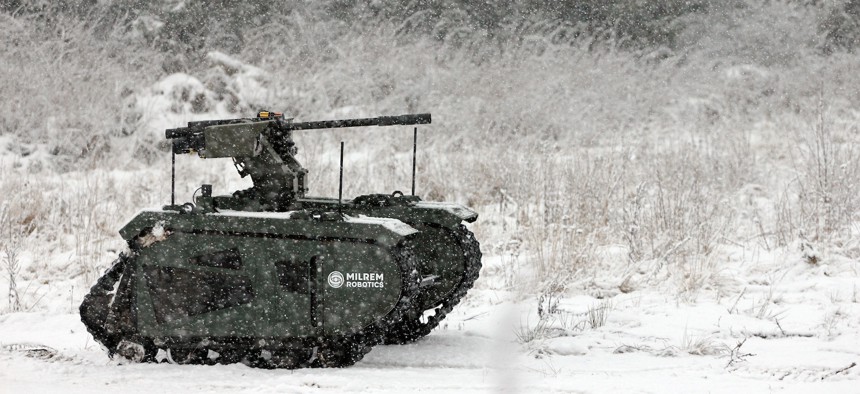
A prototype combat robot from Esonia's Milrem Robotics. Milrem Robotics
Who’s Leading the Western Response to Russia’s Warbots? Estonia
A European leader in robotic autonomy turns its attention to the battlefield.
The small country of Estonia is leading the Western response to Russian ground robots. The tiny country of 1.3 million, known among tech enthusiasts for its innovative e-residency program and for hosting NATO’s Cooperative Cyber Defense Center of Excellence, last week announced a new initiative to bring ground robots to Europe’s militaries.
According to an Aug. 2 statement from the Estonian Ministry of Defense, the country is working with Finland and Latvia to develop an unmanned ground robot in the hope of creating a “European standard” for future such machines.
Very much as in the Pentagon’s new networked-warfare concepts, Estonia’s unmanned ground vehicles will share data with aerial drones, other sensors, and human operators. But much of the machines’ steering and operation will be autonomous, according to Estonian officials. “True innovation emerges from the autonomous control system, and integration with sensors and other manned and unmanned platforms, such as UAVs, radars, control points, etc,’” Kusti Salm, the Defence Ministry’s investments director said in the statement.
The statement did not specify whether the resulting robot or family of robots will carry guns, only that the robot must be “a reliable companion for a soldier on the battlefield, one that would increase his decision making speed, reduce the load he is carrying, and increase his endurance and defence.”
The European Defence Fund has earmarked between 30 and 40 million Euros ($35 to $46 million) for the project, in addition to additional funds that will come from the participating countries, the statement said. Germany, France, and Belgium may also join.
The program follows similar Russian efforts to develop and field ground combat robots, such as the Uran-9, a large, armed tank bot that Russia has tested in Syria. But according to Andrei Anisimov, a Russian defense researcher connected to the Uran-9 project, the robot was difficult to control and demonstrated a range of just 500 meters.
Estonia may be behind Russia’s battlefield-bot efforts, but it’s ahead of Moscow—and virtually everyone else—in its development and fielding of highly autonomous commercial robots, as some residents of Washington, D.C., already know.
Go to the fashionable Logan Circle neighborhood in the heart of the city, near the famed Le Diplomate restaurant, and you might see a wheeled, suitcase-sized ground robot scooting down the sidewalk, free of human operation save for a minder trudging slowly behind. The experimental food-delivery bots are the creation of Starship Technologies, an Estonian startup by Skype alumni Janus Friis and Ahti Heinla. The company has been doing live tests on Washington’s streets since last year. Here’s a video of my dog—proudly representing carbon-based lifeforms everywhere—attacking one of the little bots, which affects a mien of dutiful indifference as it rolls across 14th Street.
“Estonia is a surprising pioneer in [unmanned ground vehicle] technology — its unmanned ground vehicles represent the growing segment of logistics, support and close combat designs that will become ubiquitous in near- to midterm combat,” said Sam Bendett, an associate research analyst at CNA and a fellow in Russia studies at the American Foreign Policy Council. “As we have seen with the Syrian trial of the Russian Uran-9 combat UGV, designing and actually using these UGVs in battle are two different things. Still, there is a growing interest in small, unmanned vehicles from a growing number of forces, and Estonia can benefit as a user and an exporter of technology it continues to develop and test.”
NEXT STORY: New Defense One eBook: Defense Technology




